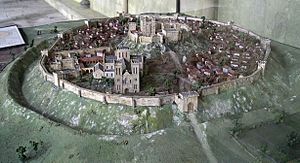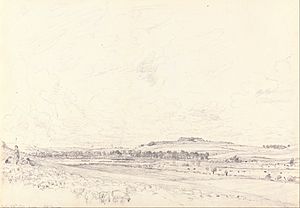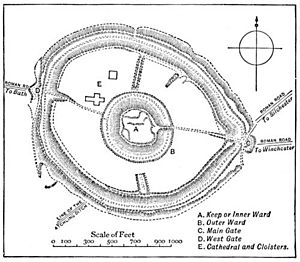Old Sarum facts for kids

Old Sarum is an ancient and ruined site in Wiltshire, South West England. It was once the very first settlement of Salisbury. You can find it on a hill about 2 miles (3.2 km) north of modern Salisbury, close to the A345 road. This historic place appears in some of the oldest records in England. Today, English Heritage looks after it, and it's open for everyone to visit.
Long ago, around 3000 BC, people built the famous Stonehenge and Avebury stone circles nearby. Signs of early settlements at Old Sarum date back to this time. Around 400 BC, during the British Iron Age, a strong hillfort was built here. It controlled important trade routes and the River Avon. People continued to live here during the Roman period, when the trade paths became proper Roman roads.
Later, in the 6th century, the Saxons took over the fort from the British. They used it as a safe place against Viking raiders. The Normans then built a motte and bailey castle, strong stone walls, and a large cathedral. A royal palace was also built inside Old Sarum Castle for King Henry I. Later, kings from the Plantagenet family used it too.
Old Sarum was important for about 300 years. But then, arguments between the local sheriff and the Bishop of Salisbury led to the church moving. A new city, New Salisbury, grew up around the building site for the new cathedral in the early 13th century. People took stones from Old Sarum's buildings to construct the new city. The old town slowly disappeared. Its castle was left by King Edward II in 1322 and sold by Henry VIII in 1514.
Even though hardly anyone lived there, the landowners of Old Sarum still had representatives in Parliament until the 19th century. This made it one of the most famous "rotten boroughs" before the Reform Act of 1832. Old Sarum was like a "pocket borough" for the Pitt family.
The 1987 novel Sarum by Edward Rutherfurd tells the story of this town.
Contents
What's in a Name?
The name "Sarum" comes from a mistake! It's a changed version of the old Latin and Norman names for Salisbury, like "Sarisburie" in the Domesday Book. These older names were based on the original British name, with Old English endings meaning "fortress" or "settlement."
The longer name was first shortened to "Sar̅". But this mark was also used to shorten the Latin ending "-um," which was common in place names. So, around the 13th century, the name got mixed up and became "Sarum." The first time "Sarum" was officially used was on a seal in 1239. Later, in the 14th century, Bishop Wyvil was the first to call himself "Bishop of Sarum."
The word "Old" was added to the name to tell it apart from New Sarum, which was the formal name for the modern city of Salisbury until 2009.
History of Old Sarum

Old Sarum has a very long and interesting history, going back thousands of years.
Early Times
The hilltop at Old Sarum shows signs of people living there as early as 3000 BC, during the late Stone Age. Early hunters and then farmers lived on the site. Around 400 BC, during the British Iron Age, the local people built a strong hill fort. They made huge banks and ditches around the hill to protect it.
This hillfort was shaped like an oval, about 400 meters (1,300 ft) long and 360 meters (1,180 ft) wide. It had two banks and a ditch in between, with an entrance on the east side. Other similar hillforts from the same time can be found nearby, like Figsbury Ring and Vespasian's Camp. An early archaeologist, Sir R.C. Hoare, called it "a very important city in the oldest times." He noted its closeness to Stonehenge and Avebury, England's two largest stone circles.
Roman Period
When the Romans arrived in Britain in the 1st century, Old Sarum was part of the land of the Atrebates. This was a British tribe possibly ruled by exiles from Gaul. Even though their first leader, Commius, fought against Julius Caesar, his sons later became allies of the Roman Emperor Augustus. Their kingdom was called the Regnenses. When one of their kings, Verica, was overthrown, it gave the Roman Emperor Claudius a reason to invade Britain.
Old Sarum appeared in old Welsh writings as "Caer-Caradog" or "Caer-Wallawg." Some historians believe it was the "Cair Caratauc" listed as one of the 28 cities of Britain in the History of the Britons.
Saxon Period
King Cynric of Wessex captured the hill in 552 AD. It remained part of Wessex after that. However, the Saxons preferred to live in valleys, like nearby Wilton. So, they mostly ignored Old Sarum until the Viking invasions. Then, King Alfred decided to strengthen its defenses again.
In the early 9th century, Egbert of Wessex often stayed there. In 960, King Edgar held a big meeting there to plan how to defend against the Danes in the north. In 1003, the Danish-Norwegian king Sweyn Forkbeard attacked and burned Old Sarum and Wilton. After this, Old Sarum became the place where Wilton's mint made coins.

Norman Period
A motte-and-bailey castle was built by 1069, just three years after the Norman conquest. The Norman kings directly owned this castle. Its commander was usually also the sheriff of Wiltshire.
In 1075, a church meeting made Bishop Herman the first bishop of Salisbury. This joined his old church areas of Sherborne and Ramsbury into one large diocese. It covered the areas of Dorset, Wiltshire, and Berkshire. Bishop Herman and Saint Osmund started building the first Salisbury cathedral. But neither lived to see it finished in 1092. Osmund was a cousin of William the Conqueror and an important official in England. He helped create the Sarum Rite (a set of church rules) and put together the Domesday Book. After many years, he was finally made a saint in 1457.
The Domesday Book was probably shown to William the Conqueror at Old Sarum in 1086. In the same year, he gathered his important church leaders, nobles, sheriffs, and knights there. They all promised their loyalty to him in what was called the Oath of Salisbury. Two other big national meetings were held there: one by William Rufus in 1096 and another by Henry I in 1116. This last meeting is sometimes called the first English Parliament.
The cathedral was officially opened on April 5, 1092. But a big storm, said to have happened just five days later, badly damaged it. Bishop Roger was a close friend of King Henry I. He acted as the king's deputy when the king was away in Normandy. Bishop Roger also managed the royal government and money. He fixed and made Old Sarum's cathedral bigger in the 1110s. This work made the cathedral twice as long. It also involved clearing a large area in the northwest part of the town for church buildings.
Bishop Roger started building a royal palace in the 1130s. This was before he was arrested by King Henry's successor, King Stephen. For a long time, people thought this palace was the small ruined building in the middle of the castle. However, a much larger palace was recently found in the southeast part of the outer castle area. This palace was huge, about 170 by 65 meters (560 by 210 ft), with a large central courtyard and walls up to 3 meters (10 ft) thick. A 60-meter (200 ft) long room was likely a great hall, and there seemed to be a large tower. After Bishop Roger's arrest, the castle was allowed to fall apart. But the sheriff and commander still managed the area for the king.
Later Medieval Times
During the Middle Ages, Old Sarum also had workshops like kilns and furnaces. Most homes were in the two southern parts of the town, built next to the ditch that protected the inner castle. King Henry II kept his wife, Eleanor of Aquitaine, as a prisoner at Old Sarum. In the 1190s, the flat land between Old Sarum and Wilton was one of five places chosen by King Richard I for holding English tournaments.
An observer in the early 12th century, William of Malmesbury, said Sarum was "more like a castle than city." He noted it had high walls. He also said that even though it had everything else, there was a big problem with water, which was very expensive. However, Holinshed disagreed, saying the hill had "plenty of springs and wells of very sweet water." Digging has found many wells, even one inside the Norman castle. But they were so deep that it was easier to bring water up the hill from the rivers by cart. The lack of water was a main reason given to kings Richard and John to move the cathedral. But it was likely only part of the problem.
A church official in the late 12th century, Peter of Blois, described his church area as "empty, dry, and lonely, open to the strong wind." He said the cathedral was "like a prisoner on the hill where it was built." Holinshed wrote that the church leaders often fought openly with the soldiers. Bishop Herbert got permission from King Richard I to move the church. The king was happy with the church because he found they were holding a lot of money and jewels for his father. But the move had to wait until King John took the throne.
By order of the Pope, Bishop Herbert's brother Richard Poore became bishop in 1217. The next year, the church leaders of Sarum asked Rome to move the cathedral. An investigation confirmed their complaints: water was expensive and sometimes limited by the castle commanders; there wasn't enough housing for the church leaders, who had to rent from others; the wind was so strong that church services couldn't be heard, and the roof was often damaged; and soldiers sometimes stopped common people from reaching the cathedral.
So, Pope Honorius III gave permission to move the cathedral on March 29, 1217 or 1218. The church leaders all agreed to the move and decided to pay for it by saving money from their incomes over the next seven years. On Easter Monday, 1219, they started building a small wooden chapel dedicated to the Virgin Mary near the River Avon. On Trinity Sunday, Bishop Poore held a church service there and blessed a cemetery. On April 28, 1220, they started building the new stone cathedral.
The town that grew around this new cathedral was first called New Salisbury, then New Sarum, and finally Salisbury. The old cathedral was officially closed in 1226. People from the new city slowly took apart the old one, using its stones to build Salisbury Cathedral and other buildings. There is proof of stone being taken until the 14th century, but the settlement was mostly empty. King Edward II ordered the castle to be taken down in 1322.
Modern Times
The castle grounds were sold by Henry VIII in 1514. From the time of King Edward II in the 14th century, the area of Old Sarum elected two members to the House of Commons. This happened even though, from at least the 17th century, no one actually lived there to vote! One of the members in the 18th century was William Pitt the Elder. By 1831, Old Sarum had only eleven voters, all of whom were landowners who lived somewhere else. This made Old Sarum the most famous of the "rotten boroughs." The 1832 Reform Act finally stopped Old Sarum from having its own members of Parliament.
Old Sarum was a special area outside of a parish. It became a civil parish in 1858, but this was ended in 1894.
The site of the castle and cathedral is a very important British monument. It was one of the first 26 places in England to be protected by the 1882 Ancient Monuments Protection Act. This protection has continued and now includes some areas west and southeast of the outer castle walls. It was also listed as a Grade I site in 1972. Today, English Heritage manages Old Sarum. Its paved parking lot and grass overflow parking are in the eastern part of the outer castle area.
Between 1909 and 1915, archaeologists W. H. St J. Hope, W. Hawley, and D.H. Montgomerie dug up the site for the Society of Antiquaries of London.
In 1917, during World War I, an aerodrome (a small airport) called 'Ford Farm' was built just northeast of Old Sarum. This became Old Sarum Airfield, which is still used today with a single grass runway.
Another excavation happened in the 1950s, led by John W. G. Musty and Philip Rahtz.
In 2014, a special survey of the inner and outer castle areas was done by the University of Southampton. This survey used tools that measure how soil conducts electricity, magnetism, and radar. It helped them find the royal palace and the street plan of the medieval city. The team planned to return in 2015 to survey the Roman-British site south of the hillfort.
See also
 In Spanish: Old Sarum para niños
In Spanish: Old Sarum para niños




